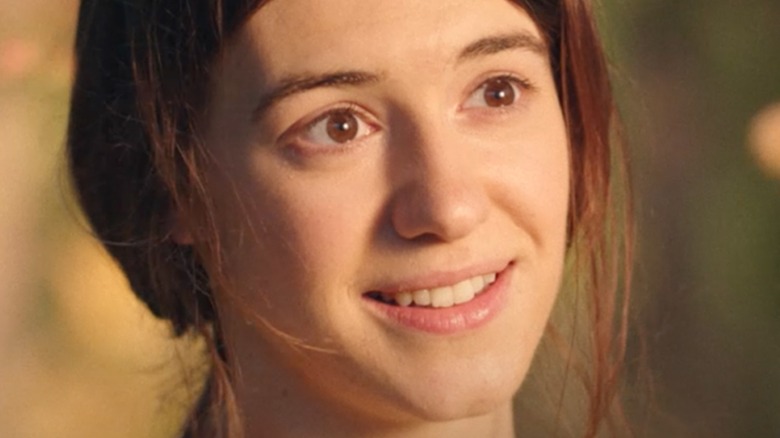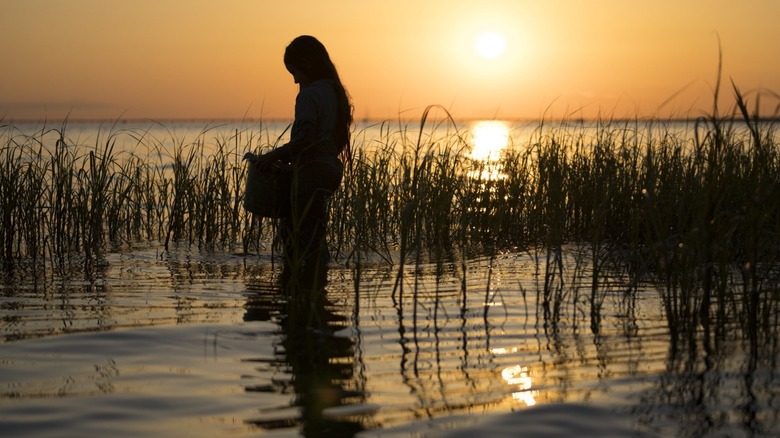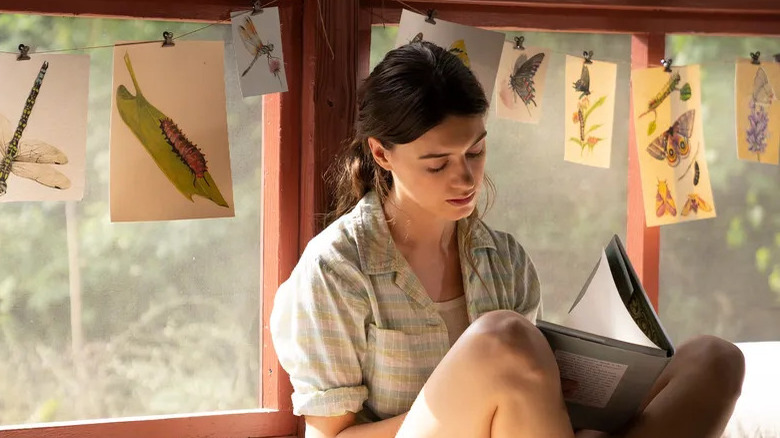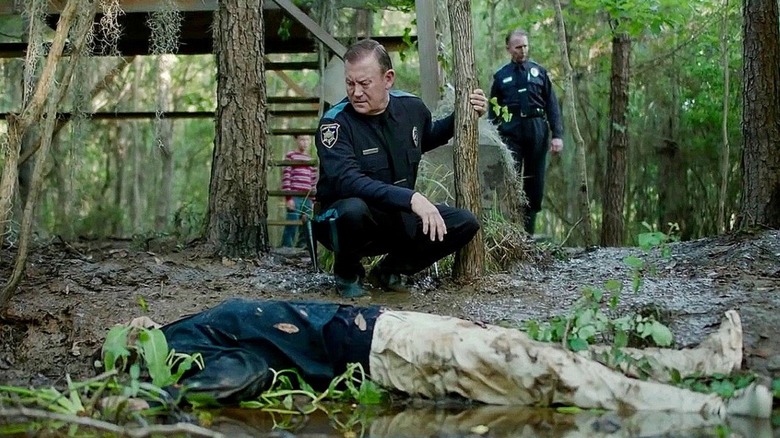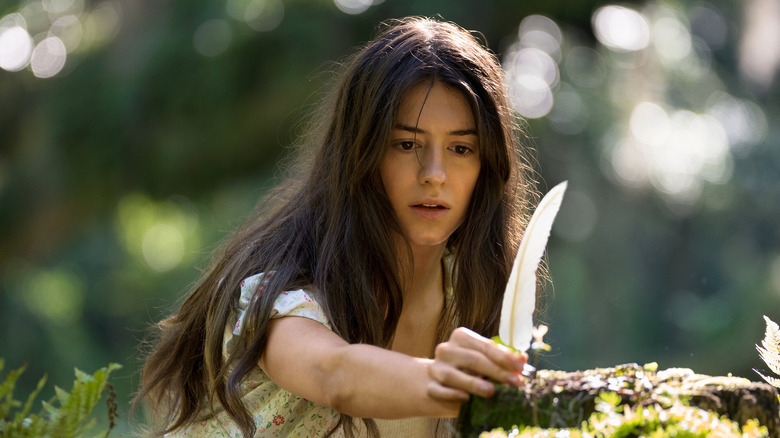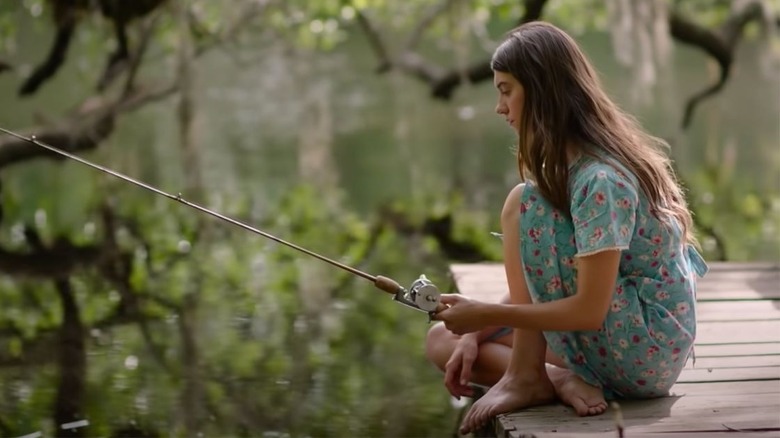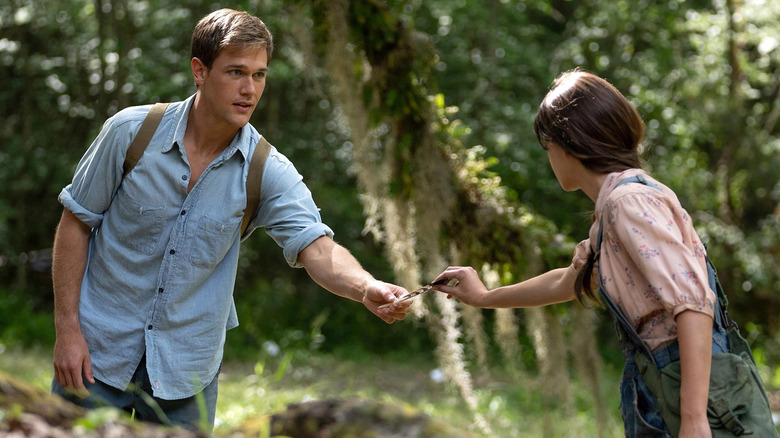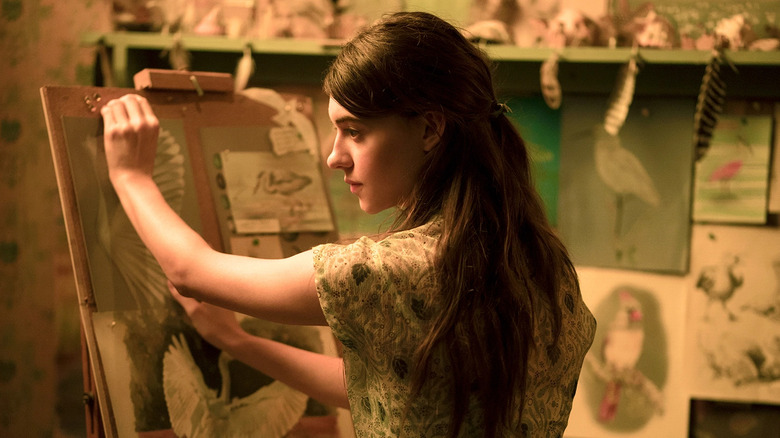The Ending Of Where The Crawdads Sing Explained
In 2018, biologist and author Delia Owens released "Where the Crawdads Sing," a murder mystery/romance interwoven with symbolism based on Owens' extensive knowledge of ecology and animal behavior. The novel was a smash hit and then some, with over 15 million copies sold (per Rolling Stone). Now, a film adaptation from director Olivia Newman and screenwriter Lucy Alibar has translated Owens' lyrical descriptions of the North Carolina marsh into a lush visual experience and sweeping cinematic journey. Like the book, the film is densely packed with symbolism, vagary, and the constant whispers of things left unsaid, leaving its ending in a whirlwind of questions.
As "Where the Crawdads Sing" unfolds, the saga of "The Marsh Girl" Kya evolves from a chronicle of her perseverance amid decades of tragedies and varying traumas into a gripping murder mystery, with Kya's very life on the line. Though the film ends with Kya acquitted of murder charges and settling down for a pleasant life with her true love Tate, it also makes it abundantly clear to those paying attention that perhaps not all is as it seems. Here is the ending of "Where the Crawdads Sing" explained, including everything left unsaid.
Kya has become her father
One of the greatest triumphs of both the novel and film versions of "Where the Crawdads Sing" is their ability to portray each and every character as a believable, sympathetic human being. Even its worst characters, like the manipulative and abusive Chase, are endowed with understandable, even respectable traits. In Chase's case, no matter how cruel he's been to Kya, he never takes off the shell necklace she made for him, not even after their breakup, and not ever as long as he still lives. Another detestable character who nonetheless reveals surprising nuance is Kya's father, known only as Pa, whom Kya eventually transforms into in a few major ways.
Pa is Kya's first antagonist, beating her and her family and causing them all to abandon Pa — and therefore Kya -– in acts of fearful self-preservation. He's unsupportive, uncompromising, and seemingly unfeeling in his relationship with young Kya, and even leaves her, in time. But Pa is a survivor through and through, from his days in World War II to his life in the unforgiving marsh, and that's exactly the skill he teaches Kya, one she relies on time and again to keep going. Throughout her abandonment by Tate, her abuse by Chase, her ridicule by the townspeople, and even her imprisonment, it's the tools Kya has learned from her father –- skepticism, isolationism, and stoic determination –- that allow her to endure.
Kya is an insect
Kya's exceptional will to survive throughout the many trials of her life is not only a reflection of her father, but it also directly reflects her myriad subjects of study as an amateur biologist. If there's one theme in "Where the Crawdads Sing" that overshadows all the others, it's that the same patterns control both the human world and the natural world. For the ever-inquisitive and fiercely perceptive Kya, many of these parallels are obvious -– she constantly refers to her enemies and lovers (often the same people) in ecological and ethological terms. But a select few of these connections slip past Kya, possibly until her final days.
When Kya first begins studying the animals of the marsh, she fixates on two distinct subjects: bivalves and birds. She's entranced with the freedom that birds enjoy by virtue of their flight, while at the same time constantly musing on the necessity of creating oneself a protective shell and hunkering down. As a child, she relies on her shell, not taking flight until Tate's earnest love sets her free. Ultimately, though, she learns to be both at once. Her last obsession leading up the murder is insects — the only taxa in history that possess both protective shells and the ability to fly. Kya learns to become an insect herself, merging the best and most useful traits of the bivalve and bird to balance her happiness and survival.
Who murdered Chase?
There's one simple way to view the ending of "Where the Crawdads Sing" that leaves the film's central plot, the murder of Chase Andrews, with an answer obvious enough to leave Kya's life tied up in a nice, neat bow. Kya is acquitted of murder, but leaves a message for Tate after her death that heavily implies she actually did murder Chase. Believing Kya to be the killer is one perfectly valid, evidence-based interpretation of the film's ending -– but there is another.
The message Kya has left for Tate contains the shell necklace that Chase wore, the same necklace that was missing, freshly taken from Chase's dead body. Kya may have killed Chase, ripped the necklace from his body in anger, and kept it safely hidden until her passing. But, on the other hand, it may have been Tate. Fibers from Tate's hat are found on Chase's body, Tate had already fought Chase over Kya, and Kya's lawyer witnesses Tate tearfully admitting something to his father. Tate had just as much motivation to murder Chase and rip the necklace from his body. It's possible that the shell-collecting Kya merely found the necklace after Tate attempted to dispose of it in the marsh and kept it hidden to protect Tate. That act of violent retribution on Tate's part may have even been the reason she suddenly took him back.
What did it all mean?
In the end, "Where the Crawdads Sing" is a dense tangle of coexisting themes, a rich ecosystem of ideas that rely on and compete with each other for survival and dominance. Obviously, Kya's (and later, Tate's) myriad ecological studies are used to create parallels and recontextualize events, but there is much more at play throughout the story. There's a strong through-line of "understandable violence," at times even "necessary violence," in Kya's life, and it comes out through the actions of her and nearly every major character in the story. The harshness of the characters' actions, even Kya's, is always unsettling but most often soaked in grim necessity or inevitability.
The latter case, inevitability, naturally flows into the brackish lakes and rivers of "nature vs. nurture" and the weight of the past. Even the most inexcusable actions, like those of Pa and Chase, still occur amid complications like the cultural climate of the time period (mainly the '60s and '70s), the rural North Carolina setting, and the characters' differing social strata. For Kya, the main motive is survival through it all, and at all costs. Though different characters focus on disparate objectives, it's Kya's unstoppable instinct to survive through the very worst of conditions that grows tallest through the thicket of competing themes.
The movie vs. the novel
If you've encountered at least a handful of reviews for "Where the Crawdads Sing," you've likely seen some serious panning. Though audiences seem to be enraptured by the film, as demonstrated by their own reviews and its solid box office performance, critics are decidedly less enchanted, resulting in a pretty drastic split between Rotten Tomatoes' critic and audience scores. In many cases, that critical disappointment stems from one major issue: the movie distills the book's complicated, thoughtful narrative into just another young adult romance, albeit in a more swampy package. Less time is spent digging into the many racial and sexual prejudices of the time and place, or exploring the nuanced motivations for the characters' choices, than on watching Tate and Kya dance and fish.
There is one positive change from book to movie, however: the ending. Yes, the core events of the film's ending are retained. Tate finds the shell necklace and a thinly-veiled confession from Kya after her death, and discards the shell, vowing to keep her secret. But whereas the book couldn't help but explain Tate's thoughts as he did so — thereby definitively revealing Kya as the killer — the movie is able to avoid this hard line and leave just a sprig of doubt.
What's next for the characters?
The futures ahead for the many "Where the Crawdads Sing" characters differ greatly. Despite the film's ambiguity and willingness to let viewers draw their own conclusions, it does end Kya's story conclusively with her death from old age. The last we see of Tate, also an old man, is him throwing the shell necklace into the Atlantic Ocean. Unlike Kya, he survives the film and may very well have more story to tell, especially if he was the murderer, or if an investigation is reopened.
Given that the story and its characters are so focused on endurance and the ceaseless march of nature, the idea of a second book following Kya and Tate's children is not much of a stretch, thematically. Likewise, given how much "Where the Crawdads Sing" focuses on the intricacies of courtship and mating, the concept of a sequel focusing on the mating pair's offspring is a natural next step. Kya is dead, and Tate is nearing the end of his life as well, but the children of the Marsh Girl may yet live on.
What's next in the series?
Author Delia Owens' star is still very much on the rise, as "Where the Crawdads Sing" is her first novel, and it's a nearly unprecedented literary success. There is a high chance that she'll continue writing more fiction, and given her almost lifelong background in ecology and animal behavior, any new books might very well follow in the footsteps of Kya's journey and symbolically link its characters with natural processes. What's more up in the air, however, is whether Owens will decide to generate entirely new fictional worlds or stay within the existing (literal) sandbox of the marsh.
A surprising and almost unbelievable complication in the potential future of Owens' work is her potential involvement in a real-life murder case, and in particular, any potential repercussions she could face if indeed she was involved. Even more surprising, the alleged murder was aired on national television during a 1996 episode of "Turning Point," hosted by Diane Sawyer. The victim's true identity was unknown but appeared to be a poacher targeting big game in Zambia's North Luangwa National Park. Owens and her husband Mark were working in the park at the time, combating the efforts of those same poachers -– the very reason for their starring roles in the documentary episode (via The Atlantic).
